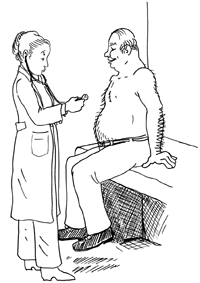STRANGE BUT TRUE- Shirt on: Amplification rules the trusty tube

DRAWING BY DEBORAH DERR McCLINTOCK
Q. At your doctor's for a routine physical, you're feeling a bit rambunctious and ask what she can hear through that trusty stethoscope of hers. "And hey, Doc," you tease, "wouldn't it be easier and more efficient if you just pressed your ear to my chest instead?"–H. Klum
A. Without missing a beat, she launches into a scholarly account of how the sounds are generated by the blood flow through the heart and by the air flow through the lungs and throat, says Jearl Walker in The Flying Circus of Physics. Either unusually high air turbulence or low turbulence ("silent chest") can indicate airflow problems and damaged lungs. Crackling and wheezing can signal obstruction, perhaps symptomatic of asthma.
"Sure, I could just press my ear to your chest, as old-time doctors used to do," she continues. "But this was awkward and embarrassing, and besides, many low-frequency sounds set up resonances inside the stethoscope tube that can be revealingly amplified by the device. "End of lecture. Now put your shirt back on, please."
Q. There's an easier word for "anthropophagy," but the practice is every bit as disgusting whatever it's called, right?–J. Dahmer
A. Make that "cannibalism," as practiced by the famous Donner Party when storms stranded them in the High Sierras in the winter of 1846-47, and by the likes of the notorious Jeffrey Dahmer and Fritz Haarmann, the Hanover Vampire. We humans are omnivores, eating entire plants and just about any part of an animal short of the hair and hooves, says Yvonne Carts-Powell in The Science of Heroes: The Real- Life Possibilities Behind the Hit TV Show.
Though rare, cannibalism can be a cultural event, as among the Fore people of New Guinea, who make it a respectful funerary ritual. Even though they cooked the bodies before eating them, they still contracted a mysterious fatal illness called "kuru," akin to mad-cow disease. Some species like the praying mantis eat their own as a matter of course, and even among those that would not, exceptions occur. For example, livestock in some countries are fed with remains from others of their species. In such cases, disease moving from the dead to the living is always a concern, so heating and sterilization are standard practice for almost any meat eaten though "humans eating steak tartare or sushi are exceptions."
Q. Is there a QWERTY in your life? Does it matter what type you are?–J. Nicholson
A. Not type but typing, since a QWERTY keyboard refers to the first six letters in the top alphabetic row of a classic typewriter or a computer keyboard. It was also called the Sholes Keyboard (1873), after Milwaukee newspaper editor Christopher Sholes. So why the QWERTY arrangement? The purpose was to split up keys that were commonly hit serially so that a too-fast typist wouldn't jam the old machines, says Howard Wainer in American Scientist magazine.
Whether QWERTY is really efficient is debated, but various alternatives have been proposed, such as by Prof. August Dvorak in 1936. According to the Guinness Book of World Records, the fastest typist averaged 150 words per minute for 50 minutes on a Dvorak keyboard, with peaks of 212 wpm! If you prefer one of these– call it a PYFGCRL– just get yourself a modern programmable keyboard and start plugging in the letters.
Footnote on the QWERTY: If you take a look at the top row, you'll see all the letters to spell "typewriter," said to have been a crafty Sholes gimmick to help early typewriter salespeople.
Q. What will happen if Dr. Evil (from Austin Powers movies) succeeds in drilling a hole and exploding a nuclear bomb in the middle of the Earth, causing every volcano to erupt? Surely he can't do this with his stated 50-kilowatt warhead. What if he used some real mega-pop?–M. Myers
A. Subterranean meltings would flow to the surface in sizzling plumes, but only after thousands of years, and Dr. Evil wants to be alive to rub his hands with glee, says California Institute of Technology's William A. Wheaton. So forget those. More to the point, the pressure wave would hit the surface within minutes, likely shaking and breaking loose rock enough to let magma escape. Trigger energy for a typical volcano is wildly uncertain, but assume 1/1000-th that of the eruption. Taking Mt. St. Helens as typical, and guessing 400 megatons equivalent released over the trigger area of 100 square kilometers, this computes to .004 MT per square kilometer necessary to pop it.
Thus, worldwide, to start the whole volcanic shebang would take 2-million-MT, or about 35,000 times the largest bomb ever exploded. Such a device would weigh approximately 200,000 tons and be at least 100 feet in diameter. Pooling the entire stockpiles of the US and former Soviet Union would probably just about do it.
"Conclusion: Barely conceivable, but Dr. Evil can forget using a normal size bomb or a small drill hole."
~
Send strange questions to brothers Bill and Rich at [email protected].
#